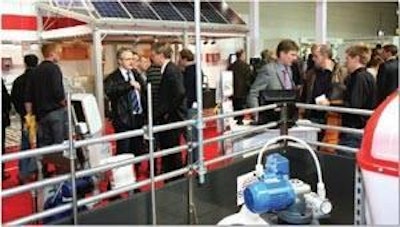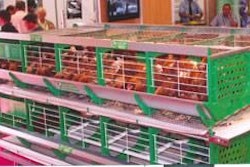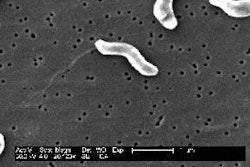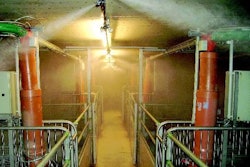
Liquid feeding of grow-finish pigs by pump and pipeline has received a fresh surge of international interest since unprecedented grain prices brought a sharp rise in feed costs. The popularity of the system in northern Europe is said to be higher than ever and it has entered new markets in Asia and North America.
Estimates vary for the uptake of liquid feeding in the growing and feeding phases on units in European countries, but the 2008 EuroTier exhibition in Germany has confirmed that there remains a North-South divide in this respect. While the system is extremely popular on northern farms, it has far fewer adherents in the southern lands bordering the Mediterranean Sea.
Over 60% of slaughter pigs in Denmark and Sweden are now liquid-fed, estimated EuroTier exhibitors, as well as a majority of Danish and Swedish sows. Both the Netherlands and France are said to be at around 33% in grow-finish on a national basis, but this disguises rates of 50-60% in their main pig regions. Relatively few of their sows are wet-fed, by contrast, with a maximum of 15-20% being suggested for the current situation in Dutch sow herds.
Nationally in Germany, the proportion is probably around 40% for grow-finish, although considerably lower for sows. The German finishing market share itself masks a regional difference in that all the big units in the east of the country and most of those in the north-west are wet-feeders, whereas smaller farms in the south are less likely to have such an installation. The national average percentage is described locally as increasing almost daily, as small farms quit and the larger ones expand.
Regional practice
Tradition and a limited availability of cheap by-products to include in feeds may supply part of the explanation for the much lower adoption of liquid feeding across southern Europe, but there can be no doubt that concerns over hygiene still influence decisions in that area. In the words of an exhibitor at EuroTier, the idea of preparing and distributing feeds in liquid form is something that has been better-suited in the past to the colder countries of Europe. Those in the warmer south have worried that they may be feeding bugs as well as nutrients because microbes grow faster when temperatures are higher.
However, places with both cool and warm climates have joined the list lately of destinations for liquid feeding. Examples include Japan, where a government initiative started about two years ago to offer grant aid for so-called biomass projects. Part of the installation cost can be paid by a state grant if the main aim is to use by-product food materials. Across the Pacific Ocean in the U.S., in wet-fed possibilities have been fired by the biofuels boom. Not only have ethanol plants taken some maize out of the feed market and therefore raised grain prices, they have also created a supply of the wet distillers' grains by-product material DDGS that is most easily fed in a liquid mixture.
Feeding liquids was calculated by the show's exhibitors as adding only marginally to the cost of an installation compared with the distribution of a dry feed. A source suggested that the breakeven point on size in northern Europe to cover the extra installation cost would be between 1,500 and 2,000 growing pigs. The higher investment items relate to the kitchen feed-preparation area and the pipeline valves. But the exhibitors declared that the expense per pig on liquid reduces as the number of pigs rises, whereas with dry feeding the start-up cost is less and the incremental costs increase with rising size.
Location and circumstances dictate how much cheaper a liquid mixture based on by-products will be compared to a complete dry feed, but a north German calculation quoted at the show indicated a saving of 20 to 30 per metric ton. The largest discount over the cost of purchased complete feeds is being obtained by those closest to the major sources of wet by-products, with the most common examples coming from the brewing and bakery industries as well as from the industrial processing of milk and potatoes.
Geography to some extent dictates whether the liquid feeding unit also has machines on the farm for milling and mixing dry ingredients. From a northern European perspective it has become more frequent that wet-feeders prepare balancing dry meals in their own mill-mix plant, but the actual proportion having such an installation varies quite sharply from one region to another. More mill-mixers can be found in local areas that are not in close proximity to a big milk factory.
Transportation considerations
Transport over any significant distance for bulky liquid by-products is often a problem, of course, and one that was made worse by higher oil costs. Variable freshness and a lack of uniformity can also be important issues with any by-product. Frequent sampling for a test of content and consistency is an essential part of the liquid feeding process. So, too, are checks that there have been no serious de-mixing of components during their passage through a long pipeline.
Ideas on layout have changed. The original version typically had a large mixing tank serving a pipeline circuit. Some of the feed flow would recycle back to the tank. On bigger farms today there are two tanks and these are of a smaller volume than in the past. One is employed in preparing the next meal while the first is going through a feeding cycle. Smaller is better for tank size from a hygiene viewpoint, specialists insist. Many farmers make the mistake of buying one that is too big for their needs. Cleanliness depends on having a size that will fill and empty completely at least once per day, rather than simply being topped off each time.
Cleaning options
The importance of regular cleaning for both tank and pipe was emphasised by all suppliers at EuroTier. They explained a range of options for this task. Acids could be added to the tank several times daily, for example, with the opposite of an alkaline treatment being administered once per week. Pipelines may be washed through with the alkaline solution every 4-6 months. There is also chemical cleaning with proprietary sanitisers and the equipment systems on offer include the use of ultraviolet light (cheap, but lamps sometimes need cleaning) to kill bacteria in the tank.
The requirement for careful cleaning arises mainly from the potential multiplication of undesirable microbes in liquid feed residues inside tanks and pipelines. But a stabilised system can be colonised by beneficial lactic acid bacteria. As a past episode in Denmark showed, cleaning the tank may even be counterproductive if it removes these lactobacilli and allows more harmful coliform bacteria to multiply in the short term before more stable conditions are restored.
Lactic acid bacteria occur naturally on cereal grains. They multiply in the wet mix. There is also a fermentation of the sugars or carbohydrates in by-products. The overall result is to make the feed more acidic. This prevents the multiplication of other bacteria in the feed (by competitive exclusion) so it excludes enteropathogens from the diet. In other words, good fermentation of a liquid feed can have health benefits for the pig. Tests have confirmed, for example, that feeding a liquid diet in which some fermentation has occurred should reduce the incidence of Salmonella and coliforms, so preventing diarrhoea. Structural components inside the gut of the pig after weaning may also be protected.
The basic choice open to any wet-feeder is whether to have natural fermentation or controlled fermentation. Natural means, by definition, not subject to an outside control that affects the final microbial population. Jens Legarth, of a Danish-based consultancy called Fermentationexperts, said at EuroTier that the lack of control would really mean in practice you did not know which bugs you started with and which ones you had at the end. The consultancy advocates the merits of controlled fermentation to liquid feeding clients in 15 countries and insists that the process can be managed successfully.
It makes a lactobacillus culture available to clients, for supply to the food factory from which liquid by-products will be sourced. The factory is asked to add the culture to the material before it is sent to the farm. After 2-6 hours of fermentation with the help of the culture before dispatch and up to 8 hours more on the farm, the by-product is intended to have a pH of between 3.8-4.0 and a good taste due to the presence of abundant lactic acid and the absence of unpleasant acetic acid.
Given the temperature sensitivity of the process, producers using this method are advised to store the liquid raw material in an insulated tank. This is emptied completely about once per month to guard against any build-up of yeast, but yeast accumulations are reckoned to depend on the source of air to the tank. Outside storage receiving fresh air is considered the most advisable, or the use of a simple chimney pipe to direct outside air into a tank in an enclosed building.
Yeast contained in such products as bakery dough and beer yeast waste makes them unsuitable for liquid feeding with controlled fermentation, since their raising of pH above 4.0 stops the sugars from fermenting. By-products from the manufacture of soft drinks also are of less value despite having a high starch content, because their pH is too low at 1.5-2.0.
Level of hygiene is key
"But there are various other by-products you can use," Jens Legarth commented. "Successful fermentation with them depends above all on the level of hygiene in the whole system, because what you are doing in effect is to change the whole microbiology of the farm. We tell our clients it is as if they were operating a cheese factory for the hygiene required. The ideal would be to have the whole kitchen area about 100 metres away from the nearest pigs so that it stayed clear also of any microbes that might transfer in the air."
He reported experience on almost 200 farms in Europe as demonstrating that the first three months is the critical time for a new installation based on fermented liquid feed. After that, changes can be made such as to the type of by-product and the system should continue without problem. Before then, however, there may be a short-term build-up of coliforms to overcome, until the lactic acid bacteria become numerous enough to dominate.
Coli bacteria do not only present a health risk to pigs. They can also destroy synthetic lysine and other amino acids in the feed — and can do this in an amazingly short time, measurable in just a few seconds. An early balance of the pH at or below 4.0 is, therefore, highly desirable.
A calculation using information from users of the controlled method in Europe has suggested that the initial installation costs are between 5-10% more than for conventional liquid feeding. Virtually all of this extra is for storage tanks. In fact the mix-pump-pipeline part of the system is reckoned to have become more affordable. Since the low pH of fermented feed allows it to be left in the pipeline without problems, say its advocates, this removes the need to return uneaten material to the mixing tank and therefore the layout can have a simple straight-line pipe instead of a full circuit.
Additionally, there are said to be paybacks from a better feed utilisation where the liquid feed has been fermented under controlled conditions. Health benefits outside the growing-finishing stage are also being explored. Some of the pioneering research in the UK, Denmark and Netherlands on possibilities for fermentation had been with 8-25kg pigs. Good growth performance figures were recorded and an opportunity seen for bringing more production stages into the wet-fed network. Whereas a regular layout would struggle to provide the small portions eaten by young pigs in a nursery, for example, with fermentation this is theoretically much simpler as the feed can stay in the pipe.
















